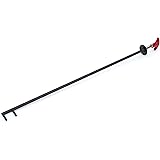The vast majority of today’s cars have serpentine belts and taking care of them is an essential task. Without them, your engine can’t power the various accessories it relies on. But exactly how long are these belts supposed to hold up? Modern serpentine belts can last for a surprisingly long time, but the following breaks down exactly how long and when you’ll need to replace them.
The Usual Numbers
Fortunately, you can expect a fairly long lifespan from a modern serpentine belt. Under ideal circumstances, you’ll get anywhere from 50,000 to 100,000 miles of reliable service from a typical serpentine belt. In terms of years, it may be anywhere from 4 years to an entire decade before you’ll need to replace your serpentine belt.
Of course, that depends largely on the type of material the belt uses. Belts made from ethylene propylene diene monomer (EPDM) tend to hold up much longer than those made from neoprene, a material used by older serpentine belt designs.
Despite your serpentine belt being able to go the distance, most car manufacturers don’t specify replacement intervals for their belts. Instead, automakers recommend that you inspect your serpentine belt during your car’s regularly scheduled service and replace it when necessary.
Factors That Affect Longevity
It’s not just the advanced materials or how long you use your serpentine belts that impacts their lifespan. For example, spilling fluids like engine coolant or transmission fluid on the belt can cause slippage and even deteriorate the rubber, cutting its life short. Any physical damage to the belt itself can also spell trouble for your serpentine belt as time goes on.
Where you use your vehicle can also affect the serpentine belt lifespan. Life in the desert with triple-digit temperatures or in areas that regularly see below-freezing temperatures can result in increased wear and tear on the belt, not to mention other vehicle components.
Don’t forget that serpentine belts are kept in tension by a hydraulic or spring-loaded belt tensioner. Think of the tensioner as a shock absorber, ensuring that the belt always makes contact with each pulley. Tensioners can wear out and weaken with age and use or even seize up in some cases. Either way, a failed tensioner can cause your serpentine belt to wear faster – that is, if it doesn’t slip off and suffer damage that way.
What Happens As Your Belt Ages
Components made from rubber tend to break down as they age, and serpentine belts are no exception. As time goes on and the miles roll on, you might notice your belt take on a shiny or “glazed” appearance. Cracks can also form along the belt’s surface and small chunks of rubber can even peel or chip off.
Old serpentine belts can lose their grip and squeal as they get older. The belt may also become misaligned, creating further wear and tear. Eventually, the squealing and chirping may give way to sudden silence as the belt snaps apart, leaving you stranded without a way to drive your engine’s crucial accessories.







